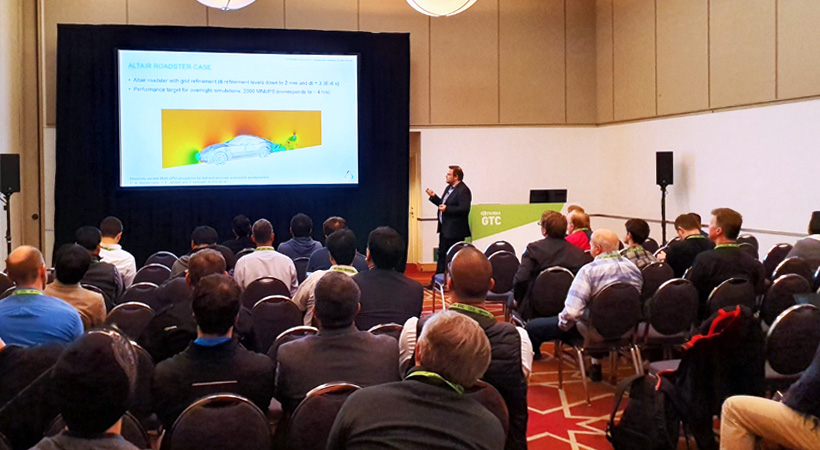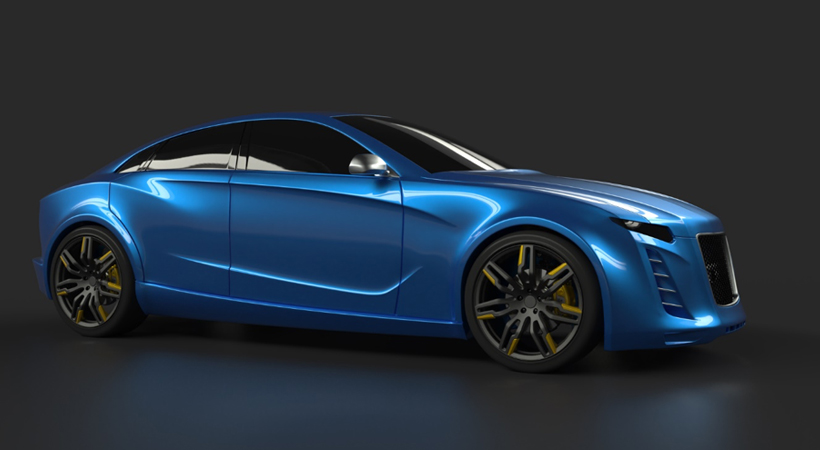The Power of Convergence: Drastically Reducing Design Validation Time
Detailed analysis of automotive aerodynamics has historically been a long and laborious process, and it could take weeks or months to complete design validation. Highly resolved, transient computational fluid dynamics (CFD) simulations based on pure CPU systems were very computationally expensive and constrained by available computational resources. For years, this posed a problem for automotive OEMs working on aerodynamic design, which has a large impact on a vehicle’s drag and lift and thus on its fuel efficiency and driving stability.
We shared details about the ultraFluidX solution earlier this year at NVIDIA’s 10th annual GPU Technology Conference (GTC) in Silicon Valley. The GTC event series focuses on high-end applications of NVIDIA’s powerful GPU technology in fields such as AI, deep learning, and computer-aided engineering (CAE).
 As part of the CAE track at GTC, we presented ultraFluidX in our talk “Ultra-Fast High-Fidelity CFD Simulations for Automotive Aerodynamics,” which was very well received by the audience during a packed session.
As part of the CAE track at GTC, we presented ultraFluidX in our talk “Ultra-Fast High-Fidelity CFD Simulations for Automotive Aerodynamics,” which was very well received by the audience during a packed session.
During the early-phase design process of a new vehicle, engineers and designers must be able to draw the right conclusions for any subsequent design iterations. Flow simulations can provide detailed insights into the flow mechanisms beyond the understanding that can be generated through wind tunnel tests, but they need to be highly accurate to do so. This level of accuracy can only be achieved through fully transient, highly resolved simulations that capture all relevant physical effects, because the flow field around passenger cars and heavy-duty vehicles is very complex and highly unsteady.
However, classical CFD approaches based on pure CPU systems need too much time for transient simulations to efficiently use them in the early-phase design process. In this initial period the exterior design freedom is largest, and several new ideas are usually sketched per day. Therefore, a feasible CFD method must be able to deliver simulation results at least overnight to be of use in this process. Otherwise, design ideas become stale while waiting for simulation results.
However, GPU resources are not yet readily available on a large scale for automotive OEMs. This problem can be solved by Oracle Cloud Infrastructure, which provides a wide variety of high-end GPU shapes that can be used on demand. For the use case of a concept car design study — the Altair CX1 — that we presented in our talk at GTC this year, we were using Oracle’s bare metal shapes BM.GPU3.8, which each feature eight NVIDIA® Tesla® V100 GPUs and NVIDIA’s NVLink™ 2.0 high-speed interconnect.
“The advantage of our bare metal shapes is that they don’t need a hypervisor, leaving the full computational power of the machine for computation,” said Karan Batta, director, product management at Oracle Cloud Infrastructure. “Customers can run these very large, highly resolved simulations overnight. These GPU shapes are also ideal for running machine learning and AI workloads.”
The performance of Oracle’s BM.GPU3.8 shapes compared well with the performance of an on-premises machine like the NVIDIA DGX-1™, allowing Oracle Cloud Infrastructure users to leverage the massive computational power of GPUs.
Do you want to learn more about how to benefit from the power of ultraFluidX for your own simulations on Oracle Cloud Infrastructure? For further details, please contact Rick Watkins, director, cloud & appliances, Altair.
Game-changing Technology for NVIDIA® GPU-based CFD
Altair has changed the game with a breakthrough technology for simulation-based design. NVIDIA GPU-based CFD using Altair ultraFluidX™ paves the way for affordable, high-fidelity simulations of fully detailed production-level passenger and heavy-duty vehicles overnight. The flow solver, developed with NVIDIA CUDA® libraries, can achieve unprecedented turnaround times of just a few hours for transient flow simulations on a single GPU-machine.We shared details about the ultraFluidX solution earlier this year at NVIDIA’s 10th annual GPU Technology Conference (GTC) in Silicon Valley. The GTC event series focuses on high-end applications of NVIDIA’s powerful GPU technology in fields such as AI, deep learning, and computer-aided engineering (CAE).
 As part of the CAE track at GTC, we presented ultraFluidX in our talk “Ultra-Fast High-Fidelity CFD Simulations for Automotive Aerodynamics,” which was very well received by the audience during a packed session.
As part of the CAE track at GTC, we presented ultraFluidX in our talk “Ultra-Fast High-Fidelity CFD Simulations for Automotive Aerodynamics,” which was very well received by the audience during a packed session.During the early-phase design process of a new vehicle, engineers and designers must be able to draw the right conclusions for any subsequent design iterations. Flow simulations can provide detailed insights into the flow mechanisms beyond the understanding that can be generated through wind tunnel tests, but they need to be highly accurate to do so. This level of accuracy can only be achieved through fully transient, highly resolved simulations that capture all relevant physical effects, because the flow field around passenger cars and heavy-duty vehicles is very complex and highly unsteady.
However, classical CFD approaches based on pure CPU systems need too much time for transient simulations to efficiently use them in the early-phase design process. In this initial period the exterior design freedom is largest, and several new ideas are usually sketched per day. Therefore, a feasible CFD method must be able to deliver simulation results at least overnight to be of use in this process. Otherwise, design ideas become stale while waiting for simulation results.
Overnight Simulation Results with Altair and Oracle
Affordable, overnight simulation results recently became possible with our GPU-based CFD solver ultraFluidX, which is based on the Lattice Boltzmann method (LBM). The LBM is explicit in time, hence inherently transient, and only requires nearest-neighbor information for each point of the computational grid. Therefore, ultraFluidX can fully leverage the computational power of the massively parallel architecture of NVIDIA GPUs. Additionally, it makes use of multiple GPUs through an efficient implementation based on CUDA-aware MPI.However, GPU resources are not yet readily available on a large scale for automotive OEMs. This problem can be solved by Oracle Cloud Infrastructure, which provides a wide variety of high-end GPU shapes that can be used on demand. For the use case of a concept car design study — the Altair CX1 — that we presented in our talk at GTC this year, we were using Oracle’s bare metal shapes BM.GPU3.8, which each feature eight NVIDIA® Tesla® V100 GPUs and NVIDIA’s NVLink™ 2.0 high-speed interconnect.
“The advantage of our bare metal shapes is that they don’t need a hypervisor, leaving the full computational power of the machine for computation,” said Karan Batta, director, product management at Oracle Cloud Infrastructure. “Customers can run these very large, highly resolved simulations overnight. These GPU shapes are also ideal for running machine learning and AI workloads.”
The performance of Oracle’s BM.GPU3.8 shapes compared well with the performance of an on-premises machine like the NVIDIA DGX-1™, allowing Oracle Cloud Infrastructure users to leverage the massive computational power of GPUs.
Do you want to learn more about how to benefit from the power of ultraFluidX for your own simulations on Oracle Cloud Infrastructure? For further details, please contact Rick Watkins, director, cloud & appliances, Altair.





